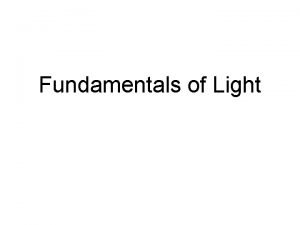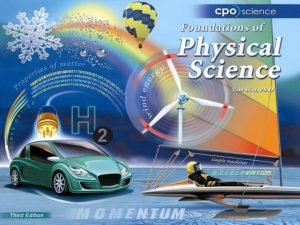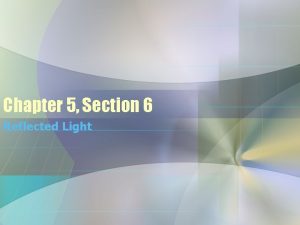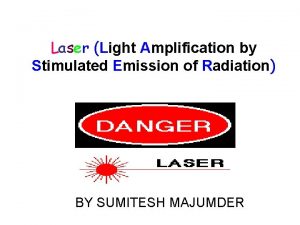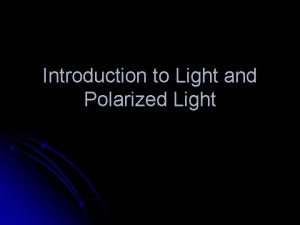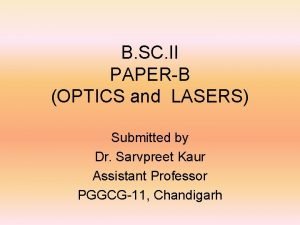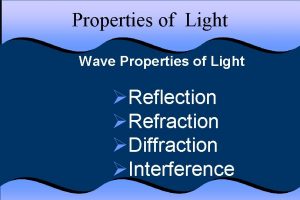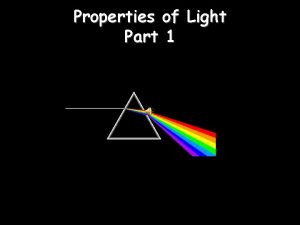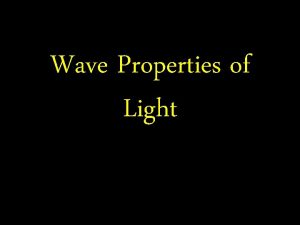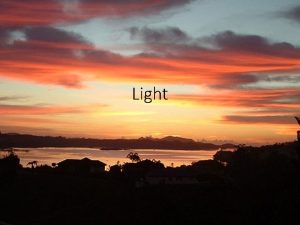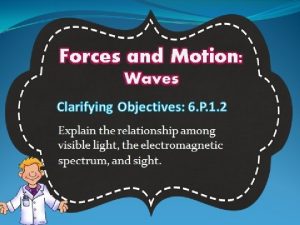Light Fundamental Properties Fundamentals of Light Light is















- Slides: 15

Light Fundamental Properties

Fundamentals of Light • Light is radiation, which we can see. • Light is only a small portion of the electromagnetic spectrum, which encompasses radiation from gamma rays to radio waves • Light DOES NOT require a medium!

Fundamentals of Light • Light is the range of wavelengths in the electromagnetic spectrum between 400 nm (4 x 10^(-7) m) and 700 nm (7 x 10^(-7) m) • nm = nanometer = 10^-9 m • A ray is a straight line that represents the path of a very narrow beam of light

Fundamentals of Light • Electromagnetic radiation is carried by particles called photons, which have a wave-like nature, and a particle like nature • Photons can be modeled with transverse waves, and can be modeled as point particles

Fundamentals of Light • Electromagnetic radiation comes from accelerating charges, or electrons changing their energy level within an atom.

Fundamentals of Light • Light has an absolute speed. We use the variable c as the constant for the speed of light • c = 3 x 10^8 m/s = 300, 000 m/s

Fundamentals of Light • A light year is the distance light travels in one year • To convert: • 1 light year X 365 days/year X 24 hours/day X 60 min/hour X 60 sec/min X 3 x 10^8 m/sec • 1 light year = 9. 5 x 10^15 m

Fundamentals of Light • Video on the measurement of the speed of light • Then a video on the Michaelson experiment

Fundamentals of Light •

Fundamentals of Light • Example 1: Find the distance to the nearest star if it is 4. 2 light years away (Proxima Centauri)

Fundamentals of Light • Example 2: One star is 10 times further than another. It is also 50 times brighter than the other. What is the ratio of the fluxes?

Fundamentals of Light • Do the worksheet • Homework is pg 332 1 -5 • DUE 2/24/16

Fundamentals of Light • Objects that are transparent allow light to pass through them. • The atoms absorb and transmit the light so it passes through the material. • Objects that are opaque do not let light pass through them. • The atoms in these materials absorb the light as kinetic energy instead of letting it pass through.

Fundamentals of Light • Transverse waves can oscillate up and down, or left and right. • The wave is therefore said to be polarized in that direction • The polarization depends on the direction of vibration the electron has. Vertically oscillating electron = vertically oscillating photon • Sunglasses can filter out light of a particular polarization, making it dimmer

Fundamentals of Light • Polarized light have vibrations that occur in one plane (vertical or horizontal), non polarized light has light which has multiple types of polarization • 3 D glasses have lenses with different polarizations, which creates the illusion of 3 D images!
 Particle number in micromeritics
Particle number in micromeritics What are the fundamental properties of color?
What are the fundamental properties of color? Light light light chapter 23
Light light light chapter 23 Light light light chapter 22
Light light light chapter 22 Light light light chapter 22
Light light light chapter 22 Fundamentals of light
Fundamentals of light Extensive vs intensive quantity
Extensive vs intensive quantity Chemical property of matter
Chemical property of matter A straight glass rod appears to bend
A straight glass rod appears to bend What are the 7 properties of light
What are the 7 properties of light 5 properties of light
5 properties of light Properties of laser light
Properties of laser light Stimulated emission
Stimulated emission What is the light
What is the light Properties of laser light
Properties of laser light Is brightness a property of light
Is brightness a property of light





